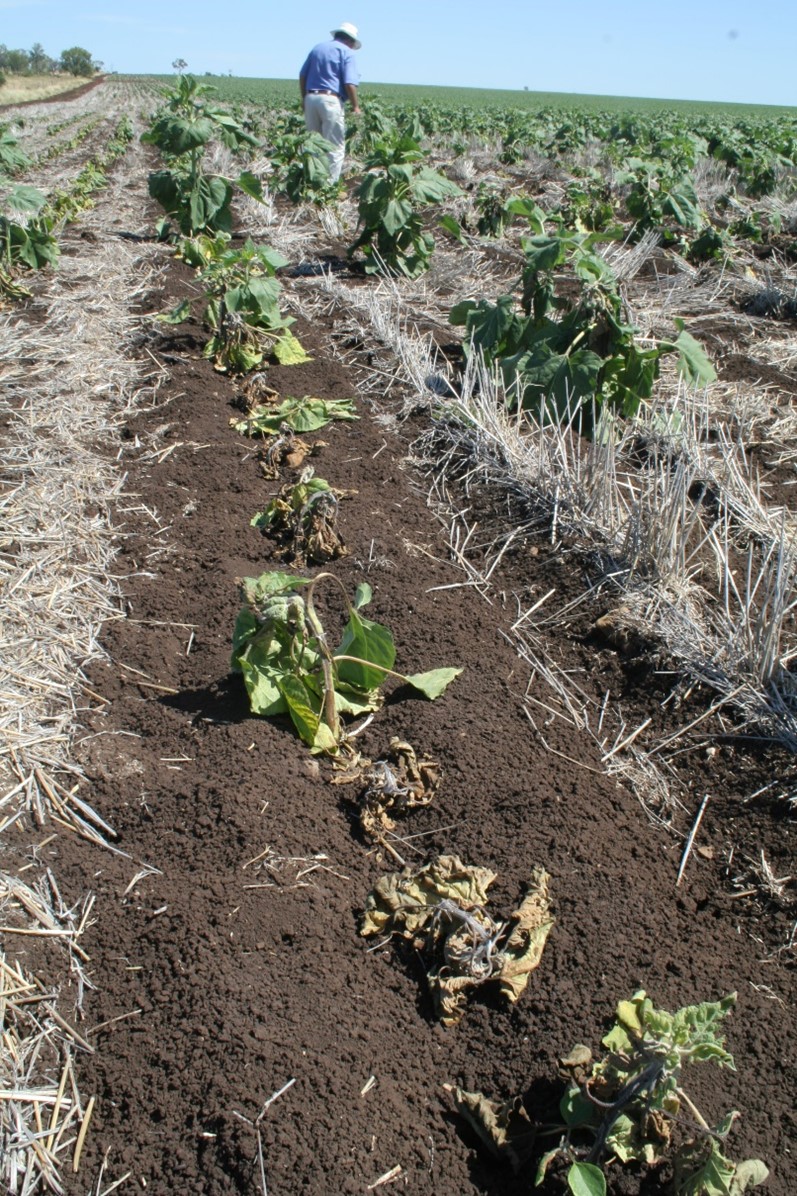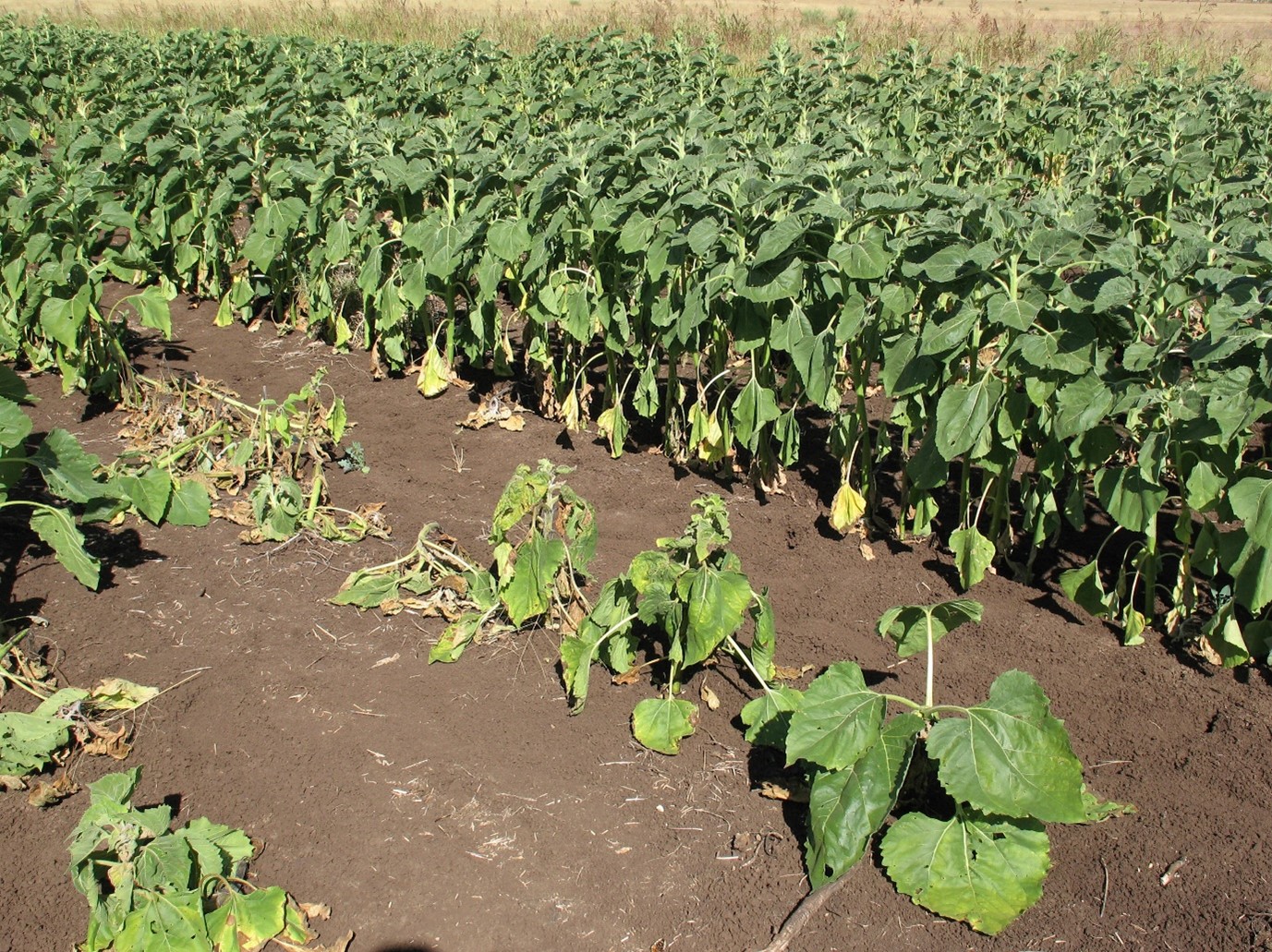The recent declaration of El Niño conditions for eastern Australia means an increased chance of below average rainfall. Historically, these conditions can lead to more severe outbreaks of tobacco streak virus. However, with forward planning and selection of suitable sunflower hybrids, the risk of economic impacts from TSV can be avoided. If sunflowers crops are planned for early 2024 in Central Queensland, to avoid TSV risk by considering the following key points:
- Understand the lifecycle of TSV virus and risks to susceptible crops in CQ.
- Prepare for the next cropping season. Reduce parthenium weed and reduce risk.
- Use a TSV tolerant sunflower hybrid in risk prone areas.
1. Understand the lifecycle and risks of tobacco streak virus
TSV is only found in the Central Highlands region of Queensland and can only survive in living plant hosts or in seed of some of those hosts (e.g. parthenium – the most important host of TSV). It does not survive in soil or on dead plant material. TSV is only transmitted to healthy plants via the feeding wounds of thrips (which allow TSV-infected pollen to enter).
Several thrips species can vector TSV and all are commonly found feeding in flowers. The prolific flowering of parthenium and crownbeard (both are common sources of TSV) make these ideal hosts for thrips which can then easily move infected pollen into nearby crops. TSV disease is favoured by climatic conditions that enable high thrips populations to develop, and large amounts of infective pollen to be produced by weed hosts. These conditions generally occur during warmer months and are highly dependent on rainfall and weed growth patterns.
The life cycle of thrips is shorter during summer months, allowing population numbers to rapidly increase. Thrips populations will generally increase as weed growth increases following intermittent rainfall, while prolonged periods of rain over many days often reduces thrips populations. The highest level of TSV disease occurs when thrips numbers are high and there are large areas of TSV-infected parthenium or crownbeard, resulting in Plants are most susceptible at the seedling stage.
Dry spring periods and intermittent summer rain following dry autumns (March – May) are most favourable for development of large populations of both parthenium and thrips that together result in more TSV disease. For example, the extremely dry conditions in Spring 2019 which lead to disturbed, bare ground that was favourable for prolific parthenium growth with summer rains, and the dry autumn of 2020 saw severe outbreaks of TSV in many mungbean crops in CQ. These conditions pose a high risk to susceptible sunflower hybrids. However, unlike mungbeans, there are several very good options for highly tolerant sunflower hybrids that display little or no disease.
2. Prepare for the next cropping season. Reduce parthenium weed and reduce risk.
Maintain crop hygiene both prior to planting and during the early stages of the crop. Spraying out areas of parthenium or slashing flowering parthenium prior to planting may also help to reduce the level of virus moving into crops.
Avoid planting close to and downwind of areas of flowering parthenium or crownbeard when crops are young and most susceptible. Where possible, avoid areas of high risk such as locations either with a history of TSV or next to areas with a high density of parthenium (e.g. neighbouring grazing paddocks), although planting upwind of high risk areas may help to reduce transmission of TSV into crops. Growing a tolerant sunflower hybrid is your best option but these tips to avoid risks are critical if you grow a susceptible sunflower hybrid or any mungbeans in CQ.

If highly susceptible hybrids are planted downwind of parthenium infestations in CQ, TSV disease can be devastating. Severe stem and terminal necrosis, and plant death is common.
In-crop applications of insecticides for thrips control are unlikely to provide effective control of TSV transmission into the crop and may disrupt effectiveness of integrated insect management systems. Field trial results of various seed treatments showed no significant difference to TSV transmission by thrips.
3. Use a TSV sunflower tolerant hybrid in risk prone areas
GRDC/DAF-funded research has demonstrated that TSV no longer poses a serious threat to the sunflower industry in CQ if tolerant hybrids are used and potential disease sources around crops are minimised. There are significant differences between some sunflower hybrids in their tolerance to TSV infection. Rating for susceptibility in field trials was based on whether plants produce harvestable seed – hence, only severely affected plants were rated as susceptible. For further information please contact Murray Sharman. Be cautious about growing new hybrids in CQ until their level of TSV tolerance is known.

Selection of TSV-tolerant sunflower hybrids is a very effective way to reduce risk of disease. Sunflower hybrids with high tolerance to TSV (rear rows) display virtually no disease compared to susceptible hybrids (front rows).
The last field trial (in 2019) tested 14 sunflower hybrids, including nine experimental lines. Hybrids from this trial that are currently available (according to Australian Sunflower Association) are shown in the table below with their relative tolerance to TSV.
Table. A selection of sunflower hybrids and their TSV tolerance.
| Hybrid | End Use | TSV tolerance |
| Ausigold 62 | Monounsaturated | Good |
| Ausistripe 14 | Bird seed | Good |
| SuperSun 66 | Polyunsaturated | Moderately susceptible |
Bringing it all together
With good crop hygiene and use of TSV-tolerant sunflower hybrids, there is no longer the risk of significant impacts from TSV disease. Where possible, maintain farm hygiene and avoid planting downwind of areas with lots of parthenium or crownbead. This is especially important when growing mungbeans which are susceptible to TSV.
Monitor crops for unusual symptoms or unexpected levels of disease. Samples can be submitted for diagnostics as part of GRDC-DAF funded projects.
Further information
- Images of TSV affected plants can be found in the Beatsheet’s disease gallery
- Type ‘TSV’ into the search box on the right to find other Beatsheet articles on this topic.
- Comprehensive information about growing sunflowers can be found at the Australian Sunflower Association website
- More detailed information on TSV research is published in: M. Sharman, D.E. Pagendam, D.M. Persley, A. Drenth, and J.E. Thomas (2016). Field evaluation of tolerance to Tobacco streak virus in sunflower germplasm, and observations of seasonal disease spread. Annals of Applied Biology. https://doi.org/10.1111/aab.12270
